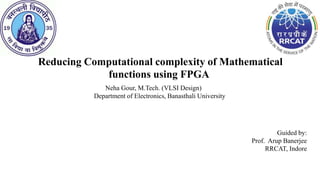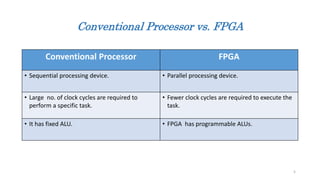Reducing computational complexity of Mathematical functions using FPGA
- 1. Reducing Computational complexity of Mathematical functions using FPGA Neha Gour, M.Tech. (VLSI Design) Department of Electronics, Banasthali University Guided by: Prof. Arup Banerjee RRCAT, Indore
- 2. Outline Introduction Motivation Conventional Processor vs. FPGA Basic skeleton of project Work carried out I. Optimization Directives II. Addition of Fixed Point Numbers III. Addition of Floating Point Numbers IV. Matrix Multiplication using Integer Numbers Result and Discussion 2
- 3. Introduction • Analysis of complex algorithm demand for less execution time and low storage space. • Computationally intensive applications such as machine learning, weather forecasting, big data, computational biology etc. • Require a lot of computation time to execute, because usually the task is sequentially simulated. 3
- 4. Motivation • To reduce the computation time and make system efficient using concept of parallelism. • Parallel processing through FPGA is one possible solution to reduce execution time. • Objective of this work is to improve the execution time of mathematical functions using optimization directives such as loop pipeline and loop unrolling. 4
- 5. Conventional Processor vs. FPGA Conventional Processor FPGA • Sequential processing device. • Parallel processing device. • Large no. of clock cycles are required to perform a specific task. • Fewer clock cycles are required to execute the task. • It has fixed ALU. • FPGA has programmable ALUs. 5
- 6. Overview of an FPGA 6 2-D array of logic blocks with electrically programmable interconnections. User can configure I. Interconnection between logic blocks, II. The function of each block. Figure: Basic structure of FPGA
- 7. Look Up Tables 7 Basic Skeleton of the Project High-Level language (C-program) LUT 1 LUT 2 LUT 3 * Parallel processing through FPGA is implemented using High-Level Synthesis(HLS).
- 8. Work Carried Out 8 C-Language APPLYING DIRECTIVES I. LOOP PIPELINE II. LOOP UNROLL FPGA Fig. Basic Block diagram of design NOTE: HLS is done by Vivado HLS(2017.2) software. Hardware implementation is done using Artix-7 FPGA.
- 9. 1. Sequential loop 9 A[5] B[5] DATA 1 2 3 4 5 1 2 3 4 5 + + + + + C[0] C[1] C[2] C[4] C[3] For(i=0; i<5; i++) { C[i]=A[i]+ B[i]; }
- 10. I. Optimization Directives 1. Loop unrolling • Loop unrolling is a directive that exploits the parallelism between loop iteration. • It creates multiple copies of the loop body and adjust the loop iteration counter accordingly. • Directive command: #pragma HLS UNROLL factor = <INTEGER>. Unrolled loop For( i=0;i<5; i++){ C[i]=A[i]+B[i]; C[i+1]=A[i+1]+B[i+1]; . . . C[i+4]=A[i+4]+B[i+4] } 10
- 12. 2. Loop Pipelining • Loop pipelining allows the operation in a loop to be implemented in a concurrent manner. • In pipelining the next iteration of loop can start before current iteration is finished. • Directive command: #pragma HLS PIPELINE initiation interval(II)* = <INTEGER>. 12 *Initiation Interval (II) is the number of clock cycles between the start times of consecutive loop iterations.
- 14. II. Addition of Fixed-Point Numbers 1. Sequential loop int i, int A[i], int B[i], int C[i]; For(i=0; i<8; i++) { C[i]=A[i]+ B[i]; } 14Fig. Fixed point addition simulation result of sequential process
- 15. 2. Loop Pipelining 15Fig. Fixed point addition simulation result after applying pipelining For(i=0; i<8; i++) { #pragma HLS pipeline II=1; C[i]=A[i]+ B[i]; }
- 16. 3. Loop Unrolling 16Fig. Fixed point addition simulation result after applying unrolling For(i =0; i<8; i ++) { C[i]=A[i]+ B[i]; C[i+1]=A[i+1]+ B[i+1]; . . . C[i+7]=A[i+7]+ B[i+7]; }
- 17. Hardware Realization of Fixed-Point Addition 1. Sequential loop 17 State 1 State 2 State 3 RESET EXIT CONDITION OPERATION EXIT=1 EXIT=0
- 18. 2. Loop pipelining 18 State 1 State 2 State 3 RESET EXIT CONDITION OPERATION EXIT=0 EXIT=1
- 19. 3. Loop unrolling 19 State 1 State 2 RESET EXIT OPERATION PARAMETERS Sequential Pipeline Unroll Loop latency 17 10 1 LUTs 50 67 117 I/O ports 142 187 468 Comparison of computational optimization Directive of fixed-point addition
- 20. III. Addition of Floating Point Numbers • For the addition and multiplication of floating point numbers we have to use floating point IPs. • Numbers written in scientific notation have three components 20 Exponent Mantissa Sign 31 30 23 8 bits 22 0 23 bits1bit Single precision format(32 bit)
- 21. Floating-point Addition Block diagram(IP) 21
- 22. 1. Sequential loop int i, float A[i], float B[i], float C[i]; For(i=0; i<8; i++;) { C[i]=A[i]+ B[i]; } 22 Fig. Floating point addition simulation result of sequential process
- 23. 2. Loop Pipelining 23 Fig. Floating point addition simulation result after applying pipelining 3. Loop Unrolling Fig. Floating point addition simulation result after applying unrolling
- 24. Hardware Realization of Floating-Point Addition 1. Sequential loop 24 State 1 State 2 State 8 State 7 State 6 State 5 State 4State 3 State 9 RESET EXIT =0 EXIT CONDITION EXIT =1
- 25. 2. Loop pipelining OPERATION RESET EXIT =0 EXIT =1 State 1 State 2 State 3
- 26. 26 3. Loop Unrolling State 1 State 2 State 3 RESET State 4
- 27. 27 PARAMETER Sequential Pipeline Unroll Loop latency 65 14 3 LUTs 272 326 1771 I/O ports 104 205 708 DSP48E 2 2 16 Comparison of computational optimization Directive of floating-point addition
- 28. IV. Matrix multiplication using integer numbers • Algorithm of Matrix multiplication start Read a[3][3],b[3][3] For i=0 to 2 For j=0 to 2 For k=0 to 2 rows C[i][j] += A[i][k] * B[k][j]; columns product * Sequential implementation of above code will take 79 clock cycles for completion. 28
- 29. 29 1. Sequential implementation of matrix multiplication Fig. Matrix multiplication simulation result by conventional method
- 30. Matrix multiplication with integer numbers Block diagram(IP) 30
- 31. 31 PARAMETER Sequential Pipelining Unrolling Loop latency 79 21 10 LUTs 142 282 367 I/O ports 41 58 270 DSP48E 1 2 6 Comparison of computational optimization Directive of Matrix multiplication
- 32. Results and Conclusion • Applications of optimization directives have explored to reduce execution time. • Loop Pipelining and loop unrolling of fixed-point addition show the reduction in delay by approx. 28% and 71%, and increase in hardware by 14% and 68% respectively, as compared to sequential. • Experimental results demonstrate that, pipelining and unrolling of floating-point addition show the reduction in delay by 72% and 91%, and increase in hardware 2 times and 5 times respectively, as compared to sequential processing. DSP48E increased by 16 from 2 slices compared to the conventional. • Loop Pipelining and loop unrolling of matrix multiplication with integer entries show the reduction in delay by approx. 73% and 87%, and increase in hardware by 30% and nearly 75% respectively, as compared to sequential. In addition increase in DSP48E slices is also observed. • Simulation results show that proposed design has reduced time complexity for mathematical functions. 32
- 33. References [1] Bob Z., ”Introduction to FPGA design” . Embedded system conference Europe.1999 classes 304- 314. [2] James H., “Floating Point Design with Vivado HLS XAP599 (v1.0)” September 20, 2012 [3] Spyridon G., John E., “Overview of High-Level Synthesis tool”. Topical workshop on electronics for particle physics. 2010 [4] Sumit G., Rajesh G., Nikhil D. D., Alexandru N., “SPARK: A Parallelization approach to the High- Level Synthesis of Digital Circuit”. 2004, Springer Science US. [5] Mohsen E., “Reducing system power and cost with Artix-7 FPGAs” . Xilinx, Artix-7, 2012:7:1-2. 33
- 34. Acknowledgement • I would like to thank my project coordinator Prof. Arup Banerjee, who gave me the opportunity to do this wonderful project. • I would like to convey my sincere thanks and deepest regards to Dr. Srivathsan Vasudevan and Dr. Satya S. Bulusu of IIT Indore for technical discussions and guidance for this work. 34
- 35. 35








![1. Sequential loop
9
A[5]
B[5]
DATA
1
2
3
4
5
1
2
3
4
5
+
+
+
+
+
C[0]
C[1]
C[2]
C[4]
C[3]
For(i=0; i<5; i++)
{
C[i]=A[i]+ B[i];
}](https://image.slidesharecdn.com/finalppt-180709143740/85/Reducing-computational-complexity-of-Mathematical-functions-using-FPGA-9-320.jpg)
![I. Optimization Directives
1. Loop unrolling
• Loop unrolling is a directive that exploits the parallelism between loop iteration.
• It creates multiple copies of the loop body and adjust the loop iteration counter accordingly.
• Directive command: #pragma HLS UNROLL factor = <INTEGER>.
Unrolled loop
For( i=0;i<5; i++){
C[i]=A[i]+B[i];
C[i+1]=A[i+1]+B[i+1];
.
.
.
C[i+4]=A[i+4]+B[i+4]
}
10](https://image.slidesharecdn.com/finalppt-180709143740/85/Reducing-computational-complexity-of-Mathematical-functions-using-FPGA-10-320.jpg)
![cont..
DATA
11
A[5]
B[5]
1
2
3
4
5
1
2
3
4
5
+
C[0]
+
+
C[1]
C[2]
+
C[3]
+ C[4]](https://image.slidesharecdn.com/finalppt-180709143740/85/Reducing-computational-complexity-of-Mathematical-functions-using-FPGA-11-320.jpg)

![cont..
13
A[5]
B[5]
1
2
3
4
5
1
2
3
4
5
+
+
+
+
+
C[0]
C[1]
C[2]
C[3]
C[4]
DATA](https://image.slidesharecdn.com/finalppt-180709143740/85/Reducing-computational-complexity-of-Mathematical-functions-using-FPGA-13-320.jpg)
![II. Addition of Fixed-Point Numbers
1. Sequential loop
int i, int A[i], int B[i], int C[i];
For(i=0; i<8; i++) {
C[i]=A[i]+ B[i];
}
14Fig. Fixed point addition simulation result of sequential process](https://image.slidesharecdn.com/finalppt-180709143740/85/Reducing-computational-complexity-of-Mathematical-functions-using-FPGA-14-320.jpg)
![2. Loop Pipelining
15Fig. Fixed point addition simulation result after applying pipelining
For(i=0; i<8; i++)
{
#pragma HLS pipeline II=1;
C[i]=A[i]+ B[i];
}](https://image.slidesharecdn.com/finalppt-180709143740/85/Reducing-computational-complexity-of-Mathematical-functions-using-FPGA-15-320.jpg)
![3. Loop Unrolling
16Fig. Fixed point addition simulation result after applying unrolling
For(i =0; i<8; i ++) {
C[i]=A[i]+ B[i];
C[i+1]=A[i+1]+ B[i+1];
.
.
.
C[i+7]=A[i+7]+ B[i+7];
}](https://image.slidesharecdn.com/finalppt-180709143740/85/Reducing-computational-complexity-of-Mathematical-functions-using-FPGA-16-320.jpg)





![1. Sequential loop
int i, float A[i], float B[i], float C[i];
For(i=0; i<8; i++;) {
C[i]=A[i]+ B[i];
}
22
Fig. Floating point addition simulation result of sequential process](https://image.slidesharecdn.com/finalppt-180709143740/85/Reducing-computational-complexity-of-Mathematical-functions-using-FPGA-22-320.jpg)





![IV. Matrix multiplication using integer numbers
• Algorithm of Matrix multiplication
start
Read a[3][3],b[3][3]
For i=0 to 2
For j=0 to 2
For k=0 to 2
rows
C[i][j] += A[i][k] * B[k][j];
columns
product
* Sequential implementation of above code will take 79 clock cycles for completion. 28](https://image.slidesharecdn.com/finalppt-180709143740/85/Reducing-computational-complexity-of-Mathematical-functions-using-FPGA-28-320.jpg)




![References
[1] Bob Z., ”Introduction to FPGA design” . Embedded system conference Europe.1999 classes 304-
314.
[2] James H., “Floating Point Design with Vivado HLS XAP599 (v1.0)” September 20, 2012
[3] Spyridon G., John E., “Overview of High-Level Synthesis tool”. Topical workshop on electronics for
particle physics. 2010
[4] Sumit G., Rajesh G., Nikhil D. D., Alexandru N., “SPARK: A Parallelization approach to the High-
Level Synthesis of Digital Circuit”. 2004, Springer Science US.
[5] Mohsen E., “Reducing system power and cost with Artix-7 FPGAs” . Xilinx, Artix-7, 2012:7:1-2.
33](https://image.slidesharecdn.com/finalppt-180709143740/85/Reducing-computational-complexity-of-Mathematical-functions-using-FPGA-33-320.jpg)

